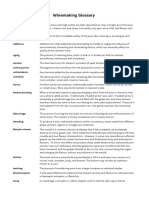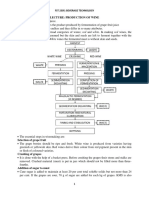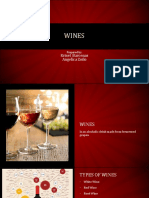Wine and Sprit
Wine and Sprit
Uploaded by
Raju JadavCopyright:
Available Formats
Wine and Sprit
Wine and Sprit
Uploaded by
Raju JadavCopyright
Available Formats
Share this document
Did you find this document useful?
Is this content inappropriate?
Copyright:
Available Formats
Wine and Sprit
Wine and Sprit
Uploaded by
Raju JadavCopyright:
Available Formats
Wines and Spirits
Wine
Wine can be defined as fermented fruit juice. Most wine is fermented grape juice, but
almost any fleshy fruit can be fermented.
Fermenting of sugar in fruits to alcohol occurs naturally, and many animals have
enjoyed getting intoxicated on fermented fruit. Thus it is not unlikely that crude wine
was humanitys first experience with alcohol.
Evidence of fermented grape juice has been seen in 8000 year old pottery shards from
China. The ancient Egyptians (5000 years ago) had a well-developed wine
production system.
Wine is mentioned many times in the Bible. Jesuss first miracle was converting
large amounts of water into wine at a wedding feast.
It all starts with grapes on the vine: and it's important that these are properly ripe. Not
ripe enough, or too ripe, and the wine will suffer. The grapes as they are harvested
contain the potential of the wine: you can make a bad wine from good grapes, but not
a good wine from bad grapes.
Teams of pickers head into the vineyard. This is the exciting time of year, and all
winegrowers hope for good weather conditions during harvest. Bad weather can ruin
things completely.
Hand-picked grapes being loaded into a half-ton bin.
Increasingly, grapes are being machine harvested. This is more cost-effective, and in
warm regions quality can be preserved by picking at night, when it is cooler. This is
much easier to do by machine.
The harvester plucks the grape berries off the vine and then dumps them into bins to
go to the winery. This is in Bordeaux.
These are machine-picked grapes being sorted for quality.
Hand-picked grapes arriving as whole bunches in the winery.
Sorting hand-picked grapes for quality. Any rotten or raisined grapes, along with
leaves and petioles, are removed.
These sorted grapes go to a machine that removes the stems. They may also be
crushed, either just a little, or completely.
These are the stems that the grapes have been separated from in the destemmer.
Reception area at a small winery. Here grapes are being loaded and then taken by
conveyor belt to a tank, from where they are being pumped into the fermentation
vessel.
This is where red wine making differs from whites. Red wines are fermented on their
skins, while white wines are pressed, separating juice from skins, before
fermentation. This fermentation vessel - a shallow stone lagar in Portugal's Douro
region - will be filled up and then the grapes will be foot trodden, so that the juice can
extract colour and other components from the skins.
This is a very traditional winery, again, in the Douro. The red grapes have been
foottrodden, and fermentation has begun naturally. These men are mixing up the skins
and juice by hand: this process is carried out many times a day to help with extraction,
and also to stop bacteria from growing on the cap of grape skins that naturally would
float to the surface.
Sometimes cultured yeasts are added in dried form, to give the winemaker more
control over the fermentation process. But many fermentations are still carried out
with wild yeasts, naturally present in the vineyard or winery.
These red grapes are being fermented in a stainless steel tank. During fermentation,
carbon dioxide is released so it is OK to leave the surface exposed. Sometimes,
however, fermentation takes place in closed tanks with a vent to let the carbon dioxide
escape.
In this small tank the cap of skins is being punched down using a robotic cap plunger.
In some wineries this is done by hand, using poles.
An alternative to punch downs is to pump wine from the bottom of the tank back over
the skins.
Here, fermenting red wine is being pumped out of the tank, and then pumped back in
again. The idea is to introduce oxygen in the wine to help the yeasts in their growth.
At other stages in winemaking care is taken to protect wine from oxygen, but at this
stage it's needed.
Once fermentation has finished, most red wines are then moved to barrels to complete
their maturation. Barrels come in all shapes and sizes. Above is the most common
size: 225-250 litres. The source of the oak, and whether or not the barrel has been
used previously, is important in the effect it has on the developing wine.
This is a much larger, older barrel, imparting virtually no oak character to the wine.
This suits some wine styles better than smaller barrels.
This is a basket press: once fermentation has completed and the young wine has been
drained off the skins, the remaining skins and stems are pressed to extract the last of
the wine that they contain.
This is a bladder press, used for some reds and almost all whites. A large bladder fills
with air, pressing the contents gently and evenly, with gradually increasing pressure.
And this is what is left at the end - the marc. It can be used to make compost.
The inside of a tank that has been used to ferment white wine: the residue consists of
dead yeasts cells.
Barrel halls can still look quite traditional. Cool underground cellars are perfect for
maturing wines - a process that takes anything from six months to 3 years
Winemakers typically check the maturing red wine barrels at regular intervals, and
top them up as some of the wine evaporates during the maturation process.
Occasionally it is necessary to move wine from one barrel to another, or from barrel
to stainless steel tank. This cellar hand is using nitrogen gas to move the wine without
exposing it to large amounts of oxygen.
Here wine is being moved from one barrel to another deliberately exposing it to
oxygen to aid in the maturation process.
Some wines see no oak at all, but are kept in stainless steel tanks to preserve the fresh
fruity characteristics.
Finally, the wine is ready and is prepared for bottling. Often, filtration is used to make
the wine bright and clear, and to remove any risk of microbial spoilage. The glass on
the left has been filtered; on the right you can see what it was like just before the
process.
Distilled Spirits
The alcohol content of beer and wine is limited by the fact that an alcohol
concentration of 18% or more kills the yeast that produces it.
To produce stronger alcohol, distillation is needed. The principle is that ethanol boils
at a temperature lower than water. So, the alcohol boils off, leaving the water behind.
You just need to capture the alcohol vapor and condense it.
The first 1% or so of what distills off has headache-inducing compounds in it, and it is
generally discarded.
Distillation was invented by the Arabs around 700 AD.
The word alcohol comes from Arabic: alkuhul, which refers to kohl, a preparation
used to darken the eyes. Alternatively, alghoul, which means monster or spirit. This
word origin is somewhat debatable.
Alcohol concentration is measured in proof, where each proof is 1/2 %. So, 80 proof
means 40% alcohol. Most distilled spirits are 80-100 proof.
Alcohol can only be distilled to 95%. It is colorless and tasteless. The color and taste
of distilled spirits come from other byproducts of fermentation and aging that remain
after distillation.
Brandy
Brandy is distilled grape wine that has been aged in oak barrels for up to 50 years.
Other fermented fruits can be distilled to produce fruit brandies of various kinds:
peach, apricot, plum, cherry, blackberry, etc.
Rum
The starting material for rum is molasses, the main byproduct in sugar manufacture.
It is first fermented (by adding yeast) to generate alcohol, and then distilled. Aging it
in wooden barrels gives it color and flavor.
Rum was invented on the sugar plantations in the Caribbean by the slaves.
Whiskey
Whiskey is a distilled spirit made from fermented grain. It is aged in wooden barrels,
usually made from white oak that have been charred. Some whiskies are distilled
several times.
Bourbon whiskey is made from corn. It was invented in Bourbon County, Kentucky
and is a distinctly American product.
Scotch whiskey is made in Scotland from malted barley plus other grains. The smoky
flavor comes from drying the malted barley over a peat fire.
Rye, wheat, and corn whiskies are made from the respective grain.
Gin
Gin is a distilled spirit flavored with juniper berries. Juniper is a gymnosperm, and
the berries are actually the cones (reproductive structures).
Gin is made by fermenting wheat, corn, and rye with malted barley, and then
distilling it with juniper berries and other spices mixed in. It does not need to be aged,
which made it an attractive product during Prohibition.
Vodka
Vodka is the traditional distilled spirit of Russia, Poland, Finland, and other Eastern
European countries.
Vodka is made from fermented grains (mostly wheat and rye), or from potatoes. It is
distilled repeatedly until it is almost pure alcohol (95% = 190 proof). Then, it is
diluted to a drinkable concentration, around 40% alcohol. Flavoring is sometimes
added at this point, but pure vodka is unflavored.
Vodka is not aged.
The Whisky Production Process
Malting
First, top-quality barley is steeped in water and then allowed to germinate. During
germination, the grain slowly changes into malt where the starch in the grain is made
ready to be converted into sugars in the mash tun. Drying in a kiln stops the
germination process.
Mashing
The malted grain is crushed and mixed with hot water into the mash tun. The sugar is
run off in liquid form, called wort.
Fermentation
The wort is cooled and then pumped into fermentation vessels called washbacks
where yeast is added and the fermentation process starts. The yeast converts the sugar
into alcohol. After 2 3 days fermentation is complete, leaving a liquid called wash
which contains 8-9% alcohol by volume.
Distillation
The wash is distilled twice. The first wash distillation produces a liquid with a low
level of alcohol known as low wines, which is then re-distilled in the spirit
still. During this second distillation only the pure centre cut, which is about 65%
alcohol by volume, is collected in the spirit receiver.
The contents are then stored in a cistern room where water is added to lower the proof
before the whiskey is placed in new charred oak barrels for aging and later bottling.
Maturation
The newly distilled, colourless spirit is filled in oak casks, while maturing the Whisky
becomes smoother and more flavoursome and draws its golden colour from the cask.
By law the whisky must be matured for a minimum of three years, but most single
malts lie in the wood for 8 years or more.
You might also like
- Project Report of Shed Net and Its Economics of Sri A Rajesh So. Praksh RaoDocument15 pagesProject Report of Shed Net and Its Economics of Sri A Rajesh So. Praksh Raorajesh rajesh0% (1)
- BarStarts Workbook Final 1540824214622Document62 pagesBarStarts Workbook Final 1540824214622Shubham bisht33% (3)
- Bar Tending Power PointDocument62 pagesBar Tending Power Pointmiguel_08100% (12)
- Expanded Transshipment ModelDocument5 pagesExpanded Transshipment ModelRaju JadavNo ratings yet
- FAO Forage Profile - Cameroon PDFDocument52 pagesFAO Forage Profile - Cameroon PDFAlbyzia100% (2)
- K To 12 Animal Production Learning ModuleDocument124 pagesK To 12 Animal Production Learning ModuleHari Ng Sablay90% (29)
- What Is WineDocument11 pagesWhat Is WineAmjad KhattakNo ratings yet
- Alcoholic Beverages PDFDocument55 pagesAlcoholic Beverages PDFKricel Maquera0% (1)
- Wine Production Methods15.4.24Document3 pagesWine Production Methods15.4.24mayank daultaniNo ratings yet
- Assignment 407Document13 pagesAssignment 407Shamim HasanNo ratings yet
- Winemaking GlossaryDocument6 pagesWinemaking GlossaryPietro Leonardi Candido OlivettiNo ratings yet
- Winemaking: Wine GrapesDocument12 pagesWinemaking: Wine GrapesAnonymous 28JsiJFaNo ratings yet
- Lecture 15 Production of WineDocument4 pagesLecture 15 Production of WineKIPRONO EMMANUELNo ratings yet
- Wine TerminologyDocument22 pagesWine TerminologysorindediuNo ratings yet
- Winery Report 13-02-2023 PDFDocument40 pagesWinery Report 13-02-2023 PDFpranay krishnaNo ratings yet
- Prathamesh WineDocument36 pagesPrathamesh WinePankaj ThakurNo ratings yet
- Basic Beverage TrainingDocument42 pagesBasic Beverage TrainingEngel ChrismonawatyNo ratings yet
- BeverageDocument67 pagesBeverageDeepak KumarNo ratings yet
- F&B Wine Part 1handoutDocument18 pagesF&B Wine Part 1handoutSuruchi BhatnagarNo ratings yet
- Types of WinesDocument91 pagesTypes of Winesrajanrld19880% (1)
- Introduction of Alcoholic BeveragesDocument15 pagesIntroduction of Alcoholic BeveragesRumvill Almeda83% (6)
- Sample Paper: Food and Beverage Operations Semester III BHMTTDocument13 pagesSample Paper: Food and Beverage Operations Semester III BHMTTAshish DigheNo ratings yet
- Food and Beverage Terminologies: Prepare By: Mellissa O. Gorosin, MbaDocument52 pagesFood and Beverage Terminologies: Prepare By: Mellissa O. Gorosin, MbaTj Kyle Dela Torre100% (1)
- Wine ProductionDocument19 pagesWine ProductionThe MatrixNo ratings yet
- Wine Basics - FaiDocument7 pagesWine Basics - FaijaisonjawaharlalNo ratings yet
- Notes 5th HM 23-24Document21 pagesNotes 5th HM 23-241208 Chetan V NaikNo ratings yet
- Wine MakingDocument5 pagesWine MakingA Ba-atNo ratings yet
- Wine GlossaryDocument1 pageWine GlossarydhillonaravinderNo ratings yet
- WinemakingDocument51 pagesWinemakingsorindediuNo ratings yet
- BeveragesDocument6 pagesBeveragesvladblacNo ratings yet
- Wine-Making in BourgogneDocument3 pagesWine-Making in BourgogneBruno CunhaNo ratings yet
- Bar Management Topic 5Document90 pagesBar Management Topic 5Axi Kamia IbalNo ratings yet
- In The Vineyard: ViticultureDocument66 pagesIn The Vineyard: ViticultureÆron DeManNo ratings yet
- Alcoholic BeveragesDocument6 pagesAlcoholic BeveragesDivya ShreeNo ratings yet
- WineDocument29 pagesWinecaldarusbiancaadelaNo ratings yet
- Wines: Krisel Barcenas Angelica ZoiloDocument37 pagesWines: Krisel Barcenas Angelica ZoiloKaye Barcenas100% (1)
- Production of Different Spirits: Presented By: Fiza KashifDocument20 pagesProduction of Different Spirits: Presented By: Fiza KashifFiza Kashif100% (1)
- Wine-Distilled Beverage-Vinegar-Fermented VegetablesDocument134 pagesWine-Distilled Beverage-Vinegar-Fermented VegetablesSumit KumarNo ratings yet
- Basic of Wine EnglishDocument9 pagesBasic of Wine EnglishMira PranadewiNo ratings yet
- Wine WorkshopDocument10 pagesWine Workshopgro BluebayNo ratings yet
- Alcoholic Beverages IDocument18 pagesAlcoholic Beverages IAngel100% (1)
- Whishky AtulDocument18 pagesWhishky AtulAnkush RaiNo ratings yet
- Wine ReportDocument18 pagesWine ReportScribdTranslationsNo ratings yet
- Manufacturing Process of Still WinesDocument12 pagesManufacturing Process of Still WinesINDRAJIT NANDANNo ratings yet
- Technology: Balneo MariaeDocument3 pagesTechnology: Balneo MariaehikivarvasNo ratings yet
- Restaurant:-: Food Drink Dessert Customers Meals Take-Out Food Delivery Services Cuisines Service Inns Taverns AntiquityDocument3 pagesRestaurant:-: Food Drink Dessert Customers Meals Take-Out Food Delivery Services Cuisines Service Inns Taverns AntiquityAMAR_BANGARNo ratings yet
- Making WhiskyDocument4 pagesMaking WhiskyKenver RegisNo ratings yet
- Bar and LiquorDocument8 pagesBar and LiquorEkoh EnduranceNo ratings yet
- AbhinashDocument4 pagesAbhinashAbhinash ReddyNo ratings yet
- F & B Service-III-HandoutsDocument119 pagesF & B Service-III-HandoutsasfawNo ratings yet
- 101 Old Time Receipts for Beer, Wine, Whiskey, other Spirits and AccoutrementsFrom Everand101 Old Time Receipts for Beer, Wine, Whiskey, other Spirits and AccoutrementsNo ratings yet
- WinemakingDocument11 pagesWinemakingAshwin Babu VargheseNo ratings yet
- VinificationDocument4 pagesVinificationAkhil ChandranNo ratings yet
- unfermented and fermented fruit bev 2Document7 pagesunfermented and fermented fruit bev 2Ankul SharmaNo ratings yet
- Wine ProductionDocument134 pagesWine ProductionChiriac MihaelaNo ratings yet
- IHM 2nd Year FNB Service NotesDocument163 pagesIHM 2nd Year FNB Service NotesHarsh Misra90% (29)
- Beer ProductionDocument20 pagesBeer ProductionEduardo AmezcuaNo ratings yet
- The Distilleries of Vancouver Island: A Guided Tour of West Coast Craft and Artisan SpiritsFrom EverandThe Distilleries of Vancouver Island: A Guided Tour of West Coast Craft and Artisan SpiritsNo ratings yet
- Chemical Engineer ResumeDocument3 pagesChemical Engineer ResumeRaju JadavNo ratings yet
- Steam Distillation ExperimentDocument7 pagesSteam Distillation ExperimentRaju JadavNo ratings yet
- Pressure Safety ValveDocument6 pagesPressure Safety ValveRaju JadavNo ratings yet
- 25 Chili Recipes by Gooseberry PatchDocument27 pages25 Chili Recipes by Gooseberry PatchGooseberry Patch86% (7)
- The Industrial Revolution Slideshow: Questions/Heading Answers/InformationDocument5 pagesThe Industrial Revolution Slideshow: Questions/Heading Answers/InformationMartin BotrosNo ratings yet
- Preservation of Vegetables by Salting or BriningDocument9 pagesPreservation of Vegetables by Salting or Briningkasun1237459No ratings yet
- B2 Organic Farming LIU043: Image: Smaack, CC BY-SA 4.0 By-Sa/4.0, Via Wikimedia CommonsDocument2 pagesB2 Organic Farming LIU043: Image: Smaack, CC BY-SA 4.0 By-Sa/4.0, Via Wikimedia CommonsMarcela Aparecida MeloNo ratings yet
- Soils and Landscape Dynamics of EritreaDocument37 pagesSoils and Landscape Dynamics of EritreaMohamedElfadlNo ratings yet
- Sheep Farming: Project ProfilesDocument4 pagesSheep Farming: Project Profilespradip_kumarNo ratings yet
- Ethanol Production From Corn PDFDocument2 pagesEthanol Production From Corn PDFAndrewNo ratings yet
- Gebbers Adamchuk PrecisionAgricultureandFoodSecurity 100212Document5 pagesGebbers Adamchuk PrecisionAgricultureandFoodSecurity 100212aliahmed.iba95No ratings yet
- Mervin LiganDocument8 pagesMervin LiganMark Allan RojoNo ratings yet
- Silage Burkina FasoDocument12 pagesSilage Burkina FasoLuqman RasheedNo ratings yet
- CMU vs. DARAB G.R. No. 100091 FactsDocument7 pagesCMU vs. DARAB G.R. No. 100091 FactsThirdy DemonteverdeNo ratings yet
- Nile Valley CivilizationDocument43 pagesNile Valley CivilizationnishantmmNo ratings yet
- Project Report: Economic Growth in AsiaDocument35 pagesProject Report: Economic Growth in AsiaVaibhav GuptaNo ratings yet
- Little Japanese CookbookDocument284 pagesLittle Japanese Cookbookandre100% (5)
- Some Observations On Grape Growing in The RepSADocument14 pagesSome Observations On Grape Growing in The RepSAMax BeeksNo ratings yet
- Telangana People's Land ManifestoDocument6 pagesTelangana People's Land ManifestorajNo ratings yet
- Agriculture SectorDocument66 pagesAgriculture SectorAyesha KhanNo ratings yet
- Rubber Tree Production Guide: I. General Description of The CropDocument7 pagesRubber Tree Production Guide: I. General Description of The CropRezelle May Manalo DagoocNo ratings yet
- Indigo Planting Harvesting Nov2017Document21 pagesIndigo Planting Harvesting Nov2017YBM REPNo ratings yet
- Farm ToolsDocument60 pagesFarm ToolsKc Kirsten Kimberly Malbun100% (1)
- Sodding A New Lawn: Site PreparationDocument4 pagesSodding A New Lawn: Site PreparationJaycee PagadorNo ratings yet
- Soybean Physiology. PURDUE PDFDocument38 pagesSoybean Physiology. PURDUE PDFJosé Inés Bazán MotaNo ratings yet
- History of Barangay TalebDocument13 pagesHistory of Barangay TalebKita kitaNo ratings yet
- Protected HorticultureDocument34 pagesProtected HorticultureBahar AliNo ratings yet
- Basic Concepts of Agricultural MarketingDocument41 pagesBasic Concepts of Agricultural MarketingGeraldine Guittap100% (6)
- AIC Organic Fertilizer For Hybrid Yellow CornDocument4 pagesAIC Organic Fertilizer For Hybrid Yellow CornGene GregorioNo ratings yet




























































































